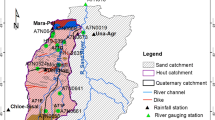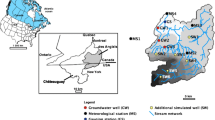Abstract
Assessment of recharge in a structurally complex upland karst limestone aquifer situated in a semi-arid environment is difficult. Resort to surrogate indicators such as measurement of spring outflow and borehole discharge, is a common alternative, and attempts to apply conventional soil moisture deficit analysis may not adequately account for the intermittent spate conditions that arise in such environments. A modelling approach has been made using the West Bank Mountain Aquifer system in the Middle East as a trial. The model uses object oriented software which allows various objects to be switched on and off. Each of the main recharge processes identified in the West Bank is incorporated. The model allows either conventional soil moisture deficit analysis calculations or wetting threshold calculations to be made as appropriate, and accommodates both direct recharge and secondary recharge. Daily time steps enable recharge and runoff routing to be calculated for each node. Model runs have enabled a series of simulations for each of the three aquifer basins in the West Bank and for the whole of the West Bank. These provide recharge estimates comparable to those prepared by earlier workers by conventional means. The model is adaptable and has been successfully used in other environments.
Résumé
Il est difficile d’évaluer la recharge d’un aquifère calcaire karstique qui présente une structure complexe et qui est localisé en montagne dans un environnement semi-aride. Le recours à des indicateurs, tels que la mesure du débit d’une source ou le rendement d’un puits, représente une alternative commune, et essayer d’effectuer conventionnellement une analyse du déficit d’humidité du sol risque de ne pas prendre en compte les conditions associées aux crues intermittentes, lesquelles sont propres à de tels environnements. A titre d’essai, une approche par modélisation a été effectuée sur le système aquifère de West Bank Mountain au Moyen-Orient. Le modèle utilise un logiciel orienté objet, ce qui permet d’activer ou de désactiver un groupe d’objets. Chacun des principaux processus de recharge identifiés sur le West Bank est incorporé. Le modèle permet soit de réaliser des calculs conventionnels de déficit d’humidité du sol, soit de faire des calculs de seuil d’humidification et il permet de prendre en compte à la fois la recharge directe et la recharge secondaire. Des pas de temps journaliers permettent de calculer en chaque noeud la trajectoire de la recharge et du ruissellement. Le modèle a permis d’effectuer des séries de simulations pour chacun des trois bassins aquifères du West Bank ainsi que pour la totalité du West Bank. Ce travail a fourni des estimations comparables à celles obtenues précédemment par des moyens conventionnels. Ce modèle est transposable et a été appliqué avec succès à d’autres environnements.
Resumen
La evaluación de recarga en un acuífero de caliza kárstica estructuralmente complejo de tierras altas es difícil. Una alternativa común consiste en recurrir a indicadores sustitutos tal como la medición de descargas de manantial y descarga de sondeos mientras que los intentos de aplicar los análisis convencionales de déficit de humedad de suelo pueden no explicar adecuadamente para las condiciones torrenciales intermitentes que se presentan en tales ambientes. Se ha utilizado un enfoque de modelizado usando el sistema Acuífero de la Montaña del Banco Occidental en el Medio Oriente como prueba. El modelo usa un programa orientado al objeto el cual permite que varios objetos se enciendan y apaguen. Se incorpora cada uno de los principales procesos de recarga identificados en el Banco Occidental. El modelo permite ya sea cálculos convencionales de análisis de déficit de humedad de suelo o cálculos de umbrales de humedad para ser hechos como apropiados, acomodando tanto la recarga directa como la recarga secundaria. Los intervalos de tiempo diario permiten calcular para cada nodo las rutas de escorrentía y recarga. Las corridas del modelo han permitido una serie de simulaciones para cada una de las tres cuencas de acuíferos en el Banco Occidental y para todo el Banco Occidental. Las simulaciones aportan estimados de recarga que son comparables a los elaborados por investigadores previos usando medios convencionales. El modelo es adaptable y se ha utilizado exitosamente en otros ambientes.





Similar content being viewed by others
References
Assaf K, Khatib N, Kally E, Shuval H (1993) A proposal for the development of a regional water master plan. Israel/Palestine Center for Research and Information, Jerusalem
Ba’ba’ MM (1996) Hydrogeological investigations in the Eastern Basin of the West Bank. MSc Thesis, Institute of Hydraulic Engineering, Delft, The Netherlands
Bachmat Y (1995) Hydrologic model of the western mountain groundwater basin for Stage 1, Harvard Middle East Water Project. Technical report Institute for Social and Economic Policy in the Middle East, Harvard University, Cambridge, MA, USA
Bredenkamp DB, Botha LJ, van Tonder GJ, van Rensburg HJ (1995) Manual on estimation of groundwater recharge and aquifer storativity. Pretoria TT 73/95, Report Water Research Commission, Pretoria, South Africa
CDM (Camp Dresser McKee) (1998) Study of the sustainable yield of the Eastern Aquifer Basin: final report. Camp Dresser McKee/Morganti Report for Palestinian Water Authority and US Agency for International Development, PWA, Ramallah
De Vries JJ, Simmers I (2002) Groundwater recharge: an overview of processes and challenges. Hydrogeol J 10(1):5–17
Flint AL, Flint LE, Kwicklis EM, Fabryka-Martin JT, Bodvarsson GS (2002) Estimating recharge at Yucca Mountain, Nevada, USA: comparison of methods. Hydrogeol J 10(1):180–204
Goldschmidt MJ (1955) Precipitation and runoff from Jordan and Litani catchments. Hydrological Paper 1, Hydrological Service of Israel, Jerusalem
Goldschmidt MJ, Jacobs M (1958) Precipitation and replenishment of the Yarqon and Nahal Hatteninim underground catchments. Hydrological Paper 3, Hydrological Service of Israel, Jerusalem
Guttman Y (1995) The hydrogeology of the Eastern Basin and possibilities for the development of water resources from the Pharaoh Stream to the Judean Desert. Report TAHAL Consulting Engineers 01/95/105, TAHAL, Tel Aviv, Israel
Guttman Y (1998) Annual report-1997: Sub Project B: Hydrogeology of the Eastern Aquifer in the Judea Hills and Jordan Valley. Report TAHAL Consulting Project 02WT9719, for German-Israeli-Jordanian-Palestinian Joint Research Program for the Sustainable Utilization of Aquifer Systems, TAHAL, Tel Aviv, Israel
Guttman Y, Zuckerman CH (1995) Flow model in the Eastern Basin of the Mountains of Judea and Samaria from the Pharoah Stream to the Judean Desert. Report TAHAL Consulting Engineers 01/95/66, TAHAL, Tel Aviv, Israel
Herczeg AL, Leaney FWJ, Stadter MF, Allan GL, Fifield LK (1997) Chemical and isotopic indicators of point-source recharge to a karstic aquifer, South Australia. J Hydrol 192(1–4):271–299
Hoetzl H (1995) Groundwater recharge in an arid karst area (Saudi Arabia). IAHS Publ 232:195–207
Hughes AG, Mansour MM, Robins NS, Peach DW (2006) Numerical modeling of runoff recharge in a catchment in the West Bank. In: MODFLOW and More 2006: Managing Ground-Water Systems, Conference Proceedings, vol 1, Golden, CO, May 2006, pp 385–389
Hydrological Service of Israel (2003) Hydrological yearbook of Israel 1999/2000. ISSN 0073–4217, Hydrological Service of Israel, Jerusalem
Jackson CR, Hughes AG, Ó Dochartaigh BÉ, Robins NS, Peach DW (2005) Numerical testing of conceptual models of groundwater flow: a case study using the Dumfries Basin Aquifer. Scott J Geol 41(1):51–60
Kilsby CG, Burton A, Moaven-Hashemi A, Tasin A, O’Connell PE (2005) Stochastic space-time modelling of West Bank rainfall for present and future climates. Report 42, SUSMAQ, Palestinian Water Authority, Ramallah, University of Newcastle, Newcastle, UK
Lange J, Greenbaum N, Husary S, Ghanem M, Leibundgut C, Schick AP (2003) Runoff generation from successive simulated rainfalls on a rocky, semi-arid, Mediterranean hillslope. Hydrol Process 17:279–296
Leduc C, Bromley J, Schroeter P (1997) Water table fluctuation and recharge in semi-arid climate: some results of the HAPEX-Sahel hydrodynamic survey (Niger). J Hydrol 189(1–4):123–138
Lerner DN, Issar AS, Simmers I (1990) Groundwater recharge: a guide to understanding and estimating natural recharge. International Association of Hydrogeologists, International Contributions to Hydrogeology 8, IAH, Wallingford, UK
Lewis MF, Walker GR (2002) Assessing the potential for significant and episodic recharge in southwestern Australia using rainfall data. Hydrogeol J 10(1):229–237
MNIWC (1999) Development of utilization and status of water resources in Israel until Fall 1998. Ministry of Natural Infrastructures Water Commission Hydrological Service, Jerusalem
Penman HL (1948) Natural evaporation from open water, bare soil and grass. Proc R Soc Lond Ser A 193:120–145
PWA (Palestinian Water Authority) (2004) Hydrogeological map of the West Bank, 1: 250 000 scale. British Geological Survey, Keyworth, for Palestinian Water Authority, Ramallah
Rofe and Raffety (1965) West Bank hydrology 1963–1965: analysis. Report Central Water Authority, Amman, Jordan
Sanford W (2002) Recharge and groundwater models: an overview. Hydrogeol J 10(1):110–120
Scanlon BR, Tyler SW, Wierenga PJ (1997) Hydrologic issues in arid, unsaturated systems and implications for contaminant transport. Rev Geophys 35(4):461–490
Simmers I, Hendickx JMH, Kruseman GP, Rushton KR (1997) Recharge of phreatic aquifers in (semi-) arid areas. International Association of Hydrogeologists, International Contributions to Hydrogeology 19, IAH, Wallingford, UK
Spink AEF, Jackson CR, Hughes AG, Hulme PJ (2003) The benefits of object-oriented modeling demonstrated through the development of a regional groundwater model. MODFLOW and More 2003: Understanding through Modeling, Conference Proceedings, Golden, CO, September 2003, pp 336–340
Spink AEF, Hughes AG, Jackson CR, Mansour MM (2006) Object-oriented design in groundwater modelling. MODFLOW and More 2006: Managing Ground-Water Systems, Conference proceedings, Golden, CO, May 2006
Stuart ME, Gooddy DC, G. Hughes AG, Jackson CR (2006) A field and modelling study to determine pesticide occurrence in a public water supply in Northern England, UK. Ground Water Monitor Rem 26(4):128–136
Wood WW, Rainwater KA, Thompson DB (1997) Quantifying macropore recharge: examples from a semi-arid area. Ground Water 35(6):1097–1106
Acknowledgements
The work was undertaken within the Sustainable Management of the West Bank and Gaza Aquifers Project which was funded by the UK Department for International Development. The project partners included the University of Newcastle and the Overseas Development Institute working alongside the Palestinian Water Authority (PWA), for whom a major outcome was training and capacity building. The development of the recharge model was undertaken by the British Geological Survey supported by the PWA for data acquisition. The paper is published by permission of the Director, British Geological Survey (Natural Environment Research Council).
Author information
Authors and Affiliations
Corresponding author
Rights and permissions
About this article
Cite this article
Hughes, A.G., Mansour, M.M. & Robins, N.S. Evaluation of distributed recharge in an upland semi-arid karst system: the West Bank Mountain Aquifer, Middle East. Hydrogeol J 16, 845–854 (2008). https://doi.org/10.1007/s10040-008-0273-6
Received:
Accepted:
Published:
Issue Date:
DOI: https://doi.org/10.1007/s10040-008-0273-6




